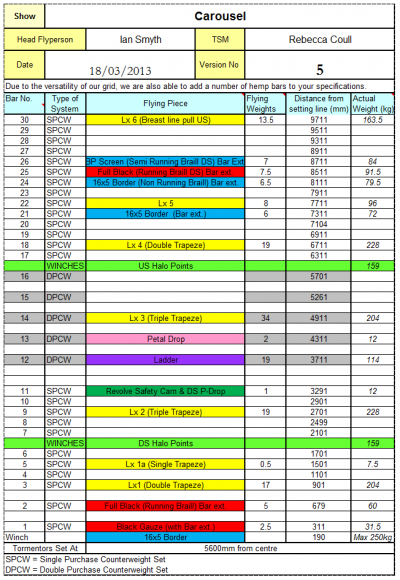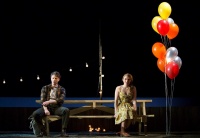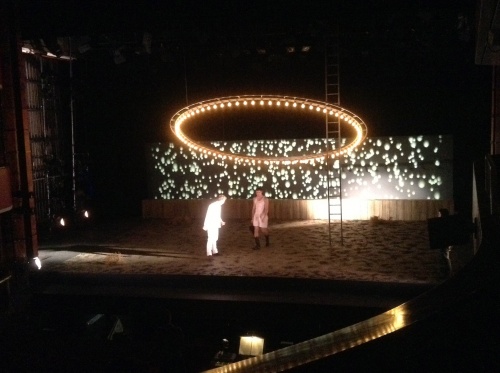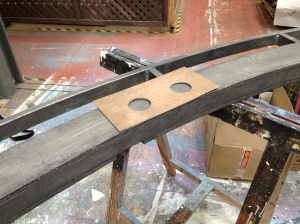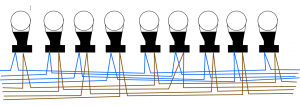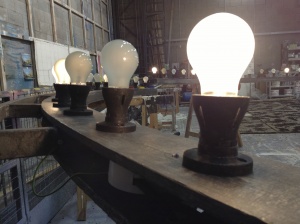Carousel 2013: Difference between revisions
SMacluskie (talk | contribs) |
|||
| (31 intermediate revisions by 7 users not shown) | |||
| Line 68: | Line 68: | ||
===Technical Production Team=== | ===Technical Production Team=== | ||
'''Stage Manager:''' | '''Stage Manager:''' | ||
'''Deputy Stage Manager:''' [[Amber McClelland]] | '''Deputy Stage Manager:''' [[Amber McClelland]] | ||
'''Assistant Stage Management:''' | '''Assistant Stage Management:''' [[Mark Blythe]], [[Stuart Lord]] | ||
'''Technical Stage Manager:''' [[Rebecca Coull]] | '''Technical Stage Manager:''' [[Rebecca Coull]] | ||
''' | '''Flyperson:''' [[Ian Smyth]] | ||
''' | '''Automation Operator:''' [[Fraser Milroy]] | ||
'''Revolve Operator:''' [[Mary Crook]] | |||
'''Chief Electrician:''' [[Neil Foulis]] | '''Chief Electrician:''' [[Neil Foulis]] | ||
| Line 94: | Line 96: | ||
'''AV Operator:''' [[Robert Butler]] | '''AV Operator:''' [[Robert Butler]] | ||
'''Sopt Operators:''' [[ | '''Sopt Operators:''' [[Kieran Fitzpatrick]] & [[Shannon Howard]] | ||
==Sound== | |||
'''Sound Number 1 and Sound Designer - Blair Omond''' | |||
'''Sound Number 2 - Laura Dougan''' | |||
==Production Arts Team== | |||
'''Assistant Carpenter''' [[Robert Gear]] | |||
'''Assistant prop maker''' [[Zoe Kemp]] | |||
==Sound Department Kit List== | |||
==Control Kit== | |||
- 1x Midas Pro 6 Console (FOH) | |||
- 1x Midas DL371 (Control Room) | |||
- 2x Midas DL251’s (Control Room and Pit) | |||
- 1x Klark Teknik DN9331 Graphic (FOH) | |||
- 1x Apple Mac G5 with Protools and QLAB 2 | |||
- 1x Digi Design 003 Rack | |||
==Speakers and Amps== | |||
- 2x d&b E12’s (Stalls Left and Right) | |||
- 4x d&b E8’s (1st and 2nd Circle Left and Right) | |||
- 2x d&b Qi7’s (Bottom of Centre Cluster) | |||
- 3x d&b Qi Subs (Upper Section of Centre Cluster in Cardioid Arrangement) | |||
- 4x d&b E0’s, Black (Stalls Front Fills) | |||
- 12x d&b E0’s, White (Stalls, 1st and 2nd Circle Delay Fills) | |||
- 6x d&b E3’s (Stage Foldback) | |||
- 11x d&b D6 Amps (10x Permanent Install, 1x Rack Mounted in Pit) | |||
- 1x d&b D12 Amp (Permanent Install) | |||
- 1x Mackie Powered Monitor (MD Monitor) | |||
==Radio Microphones== | |||
- 6x Shure UR1M Packs | |||
- 17x Shure UR1 Packs | |||
- 1x Shure UR2 (Director’s God Mic) | |||
- 12x Shure UR4D Dual Receivers | |||
- 23x DPA 4066 Pink Headsets with Mini XLR Connector | |||
==Radio Microphone Show Frequencies== | |||
All G1E Frequency Band, UHFR, 10mW Transmitter Power | |||
- 510.400 MHz - Phil Atkinson - Starkeeper and Doctor Seldon | |||
- 501.775 MHz - Greg Barrowman - Mr Bascombe | |||
- 487.325 MHz - James Baxter - Ensemble | |||
- 486.975 MHz - Emily Byrt - Julie Jordan | |||
- 525.950 MHz - Ruby Day - Carrie Pipperidge | |||
- 524.650 MHz - Ryan Ferrie - Enoch Snow | |||
- 515.500 MHz - Will Gosnold - Policeman and Ensemble | |||
- 514.025 MHz - Danni Irvine - Nettie Fowler | |||
- 491.675 MHz - Lyndsey Knox - Mrs Mullin | |||
- 490.900 MHz - Thomas Milligan - Ensemble | |||
- 495.350 MHz - Hayley Mulcrone - Ensemble | |||
- 494.150 MHz - Chris Pollard - Billy Bigelow | |||
- 497.025 MHz - Charlotte Smith - Ensemble | |||
- 495.775 MHz - Jeff Smyth - Jigger Craigin | |||
- 524.300 MHz - Ashlee Rose Soldo - Ensemble | |||
- 522.900 MHz - Kara Swinny - Ensemble | |||
- 490.300 MHz - Sarah Swire - Louise Bigelow and Ensemble | |||
- 488.300 MHz - Beth Taylor - Ensemble | |||
- 519.425 MHz - Matthew Tomlinson - Ensemble | |||
- 518.075 MHz - Claire Wallis - Heavenly Friend and Ensemble | |||
- 513.525 MHz - Robert Wallis - Ensemble | |||
- 511.100 MHz - Alistair - Enoch Junior | |||
- 521.775 MHz - Saoirse - Enoch’s Daughter | |||
- 520.200 MHz - Andrew Panton - Director | |||
==Microphones / DI Boxes== | |||
- 6x AKG SE 300’s | |||
- 2x DI Boxes | |||
==Microphone Stands / Cabling== | |||
- 1x Stereo Mic Bar | |||
- 4x Straight Stands (E0 Front Fills) | |||
- 7x 20m XLR Cables (Pit) | |||
- 1x 3m XLR Cable (Pit Amp Patch) | |||
- 1x 16 Way 5m XLR Loom (Radio Mic to Stage Box in Pit) | |||
- 1x 8 Way 5m XLR Loom (Radio Mic to Stage Box in Pit) | |||
- 1x 16 Way 3m XLR Loom (Control Room Amp Patch) | |||
- 1x 8 Way XLR to 1/4” Jack Loom (DigiDesign to Desk) | |||
==Orchestra== | |||
All of the orchestra were located in the orchestra pit | |||
- 2x Flutes | |||
- 1x Oboe | |||
- 2x Clarinets | |||
- 1x Bassoon | |||
- 3x French Horns | |||
- 2x Trumpets | |||
- 3x Trombones | |||
- 1x Tuba | |||
- 1x Harp | |||
- 2x Piccolos | |||
- 4x 1st Violins | |||
- 3x 2nd Violins | |||
- 2x Violas | |||
- 2x Cellos | |||
- 1x Double Bass | |||
- 1x Percussion | |||
=<span style="color: #730063;">'''Stage Management'''</span>= | =<span style="color: #730063;">'''Stage Management'''</span>= | ||
==Stage Management Sources== | ==Stage Management Sources== | ||
{| border="1" cellpadding="20" cellspacing="0" | {| border="1" cellpadding="20" cellspacing="0" | ||
!'''Item''' | !'''Item''' | ||
| Line 147: | Line 257: | ||
=<span style="color: #730063;">'''Technical Stage Management'''</span>= | =<span style="color: #730063;">'''Technical Stage Management'''</span>= | ||
[[Image:Carousel Flyplot.png|400px]] [[Image:Carousel Stage Plan.JPG|700px]] | |||
==Scenic Elements== | |||
'''Cloths''' | |||
*16x5 border (Winch bar) | |||
*Black sharkstooth gauze (CW1, short bar extensions.) | |||
*16x8 full black masker (CW2) | |||
*13x1 Border (hung off hemp bar for petal drop – DS of CW13, masking movement) | |||
*16x5 border (CW21, gridded to mask upper wall back wall and grid, with bar extensions.) | |||
*16x5 border (CW24, 6000mm from stage level, with bar extensions and pick ups) | |||
*BP Screen (CW25, with bar extensions and pick ups, tension lines from grid down sides to stretch to.) | |||
*8m+ legs (off US of flyfloor to mask light leak from behind BP screen) | |||
''' | '''Other flown items''' | ||
*Bucket blossom drop (CW11 operated by pull cord from flys) 16 pieces of confetti per show.) | |||
*Starkeeper’s Ladder (CW12 – runs between tension lines to brace and stop swinging) | |||
*Petal drop (Flown between CW13 and hemp bar DS of, operated by pulling up CW) | |||
*Halo ring (flown on automation winches, can fly in straight or with an US-DS tilt) | |||
'''Fixed set''' | |||
* | *Revolve (operated from under LX tower SL, by DSM position) | ||
* | *Built up stage (to hide revolve) | ||
* | *Wall (along back of set in front of BP screen – 300x300x300 box steps added either side to allow step up to wall.) | ||
* | *2.4x6m Hard Maskers x2 (Edges of US aperture) | ||
'''Trucks''' | |||
*Billy’s Hut (Small Carnival booth – set DS during A1S1) | |||
*Nettie’s Truck (Large red truck, with 4 trunk legs, on wheels; a plank revoke is set behind by cast to allow them to walk from truck to wall; separate 3 step treads with flat top) | |||
*Julie’s Truck (Large pale coloured truck, with 3 long base sections, on wheels; separate 2 step treads with railing) | |||
'''Other''' | |||
*Trees x3 (spigoted into floor for first Act; USR, USL & DSL; floor infills for following acts) | |||
*Benches x2 (carried on and off by cast) | |||
*Pallets x9 (some bolted together to allow ease of lifting; built into stack for A2S2) | |||
*Post box (spigot into floor; lights up). | |||
==Revolving Stage (Dundee Rep Revolve)== | |||
Centre stage for this performance there was a revolving stage, 6m in diametre. We borrowed this from Dundee Rep; in order to power it we also hired jumps, distro and a variable RCD from Tower Productions Edinburgh. The stage surround and ramps were built by the RCS Workshop. | |||
Please see [[Dundee Rep Revolving Stage]] for more details, power requirements and operational instruction. | |||
'' | ''Note: for this production we situated the operator DSL by the DSM position in order to allow her a clear line of sight when operating, she also had a monitor with an overhead view. These were initially safety measures to allow a double check of performers and set positioning before movement. However as we experienced issues with the revolve stopping on the correct marks the operator stopped the revolve by pressing the stop button on the control at a particular point which would allow it to decelerate and stop at the correct position, to do this she put marks on the monitor, where she would press stop when it passed this. | ||
==Halo Ring on Automation== | |||
'''Overview''' | |||
{| style=" border: 4px solid #000000; background-color: #FFFFFF; float: right; clear: right; margin: 2px; width: 22em;" | |||
! style="background-color: #FFFFFF; font-size: 75%;" align="center" colspan="2"| <span style="color: #000000;">'''Carousel Grid: Line Drop Points '''</span> | |||
|- | |||
| align="center" | [[Image:Carousel Grid Points.JPG|500px]] | |||
|- | |||
|} | |||
One of the main features of the design was the halo ring which lit up and flew in to almost the deck and out to amongst the Lx rig, it also was required to tilt on an US-DS axis. This was tricky as it required that the Lx bars were rigged on trapeze bars and on very precise points on the bars – please see Lx Trapeze Bar points for details. | |||
The other challenge with this was rigging it from the automation itself, various methods were discussed; including counterweight slave bars, flying it directly from the winch lines and hanging truss or bars from the winch lines to then hang the halo from. In the end we went with the final option as the weight change when it tipped would have made weighting it correctly on a counterweight bar difficult; we could not fly it directly from the lines at the winch line drops can only be placed in particular positions on the grid and none of these lined up correctly with the pick up points on the Halo. The final option was what we went with, the automation lines ran down to a bridle, which was attached to a pair or scaffold steel bars clamped together with vertical couplers, from this 6m drifts to the ring itself. This allowed us the greatest control over the weight distribution and tilt. | |||
'''Stats''' | |||
* | *Halo ring constructed in 3 sections which are bolted together. | ||
* | *Individual section weighs 53kg – complete halo weighs 159kg (plus weigh5t of scaffold bars on the winch lines) . | ||
*The Halo has an outside diameter of 6 metres. | |||
*The pick-up points on the halo are if put into a square 3895mm from each other. | |||
*We set the minimum height the halo came in to as 300m, the absolute maximum it could fly out was 6500mm. | |||
'''Equipment Used''' | |||
*X4 Stage Technologies winches | |||
*X4 Short black and red 24kN strops | |||
*X4 3.2T shackles | |||
*X8 1.5m drift | |||
*X8 1T shackles | |||
*X8 ¾ T shackles | |||
*X4 6m drifts | |||
*X8 barrel clamps | |||
*X8 vertical scaff couplers | |||
*X4 7.4m lengths of steel scaff. | |||
''' | '''Rigging''' | ||
Pairs of steel bars are attached together using 4 vertical scaff couplers for each pair. | |||
*The scaff couplers are spaced 985mm and 2950 from the centre of the bar out each way. | |||
The barrel clamp points on the bottom bar (which are attached to the drifts to the halo) are 1948 from centre of the bar each way. | |||
The | The barrel clamp points on the top bar (which are attached to the bridle) are 2000mm and 3400mm from the centre of the bar each way. | ||
The each bridle is attached to the short strop from the winch line wedge socket using a 3.2T shackle to the line, two 1.5m drifts are attached to this, to a 1T shackle on the end of each drift to the barrel clamp on the bar. | |||
The halo is attached via the remaining shackles and 6m drifts to the barrel clamp on the bottom bar. | |||
==Lx Trapeze Bars== | |||
In order for the Halo to fly up in among the lighting rig, the lx bars surrounding it had to be rigged on trapeze. | |||
''' | {| style=" border: 4px solid #000000; background-color: #FFFFFF; float: centre; clear: left; margin: 2px; width: 22em;" | ||
! style="background-color: #FFFFFF; font-size: 75%;" align="center" colspan="2"| <span style="color: #000000;">'''Carousel: Lx Trapeze Bars '''</span> | |||
|- | |||
| align="center" | [[Image:Carousel Lx Trapeze Bars.JPG|500px]] | |||
|- | |||
|''Note: CW - Measured from centre of Counterweight bar; Tpz - Measured from centre of Trapeze Bar'' | |||
|- | |||
|} | |||
* | '''Trapeze Bar Lenths''' | ||
*Lx1 - x2 6.4m | |||
*Lx1a - 1m | |||
*Lx2 - x2 3m and x1 4m | |||
*Lx3 - x2 3m and x1 4m | |||
*Lx4 - x2 6.4m | |||
'' | '''Equipment Used''' | ||
*x44 barrel clamps | |||
*x44 1T bow shackles | |||
*x18 6m drifts | |||
*4 2m drifts (used for Lx1) | |||
' | ==Starkeeper's Ladder== | ||
'''Overview''' | |||
During the second act a ladder was required to fly in and a performer to be able to climb it. To do this workshop built a ladder from steel which made it very sturdy (and very heavy at 100kg), which was then rigged from a secondary bar rigged to the counterweight bar by vertical couplers – this made the weight distribution on the bar better and stopped it bending). | |||
To prevent the ladder swinging when the performer climbed it, it flew between two tensioned lines - turfer line and a ratcheted drift which were attached using a series of strops in a bridle to the structural beams at flyfloor level, until the lines were in the correct position. | |||
''' | '''Equipment Used''' | ||
*Turfer | |||
*15m 8mm 7x19 construction drift | |||
*x4 2m strop | |||
*x2 masterlink | |||
*x3 3.2T shackle | |||
==Petal Drops== | |||
===Main Petal Drop=== | |||
===Small Petal Drop=== | |||
==Lx Towers== | |||
There were 3m high platforms put in place on either side of the stage well offstage and tight behind the tormentors for Lx follow spot positions. | |||
'''SL Platform''' | |||
This platform was constructed over the DSM desk position, tight to the onstage edge of the door. | |||
''Equipment Used'' | |||
*8x4 steel deck | |||
*X4 3m legs | |||
*3.1m scaff bar. | |||
*x4 swivel clamps | |||
*90 degree scaff clamp | |||
*X2 4ft long railings. | |||
*X4 M10 bolts and nuts | |||
*X5 Key clamp feet | |||
*1m deck leg | |||
*X1 ratchet | |||
The tower was built on 4 3m legs with key clamp feet; the US edge was braced using the 3.1m scaff bar and 2 swivel clamps. The DS onstage leg was clamped near the top and the bottom to the tormentor (which was drop bolted in place) using swivel clamps. The DS offstage leg had a 1m deck leg with a key clamp foot attached to it (with the 90degree clamp) bracing it against the wall and a ratchet was attached to the DS of the deck and to an eye loop bolted onto the wall to pull it tight in. | |||
This all made the tower very stable, the railing was then added. | |||
To access the platform a truss ladder was hung from the fly floor using: | |||
*X2 1m strops | |||
*X4 mailons | |||
*X1 truss ladder | |||
An inertia reel was rigged by venues and the operator was required to wear a harness attached to this to go up. | |||
'''SR Tower''' | |||
The stage right tower was constructed in the same manner, however a 4x4 deck was used and only one railing. A fixed ladder was attached to this deck. The operator was still required to wear a harness. | |||
==General Notes== | ==General Notes== | ||
===Masking Notes=== | ===Masking Notes=== | ||
*Two 4x12 legs tied off to the US of the flyfloors prevented the light leak from behind the BP screen into the US wings. | |||
*The USL entrance to the wing was masked by a 4x3.8 tab tied to a pipe along the ceiling to hide the entrance from scene dock to US and the props table also situated there. | |||
*The US wall had light leaks between the planks, we stapled black tat over these gaps on the inside of the wall. | |||
*A 13x1m border was hung along the DS of the main blossom drop. | |||
*Black tat was cable tied to the scaff bars the halo was rigged from to mask them more when the halo was in its lowest positions. | |||
'''BP Screen''' | |||
*48mm scaff pipes were put through the bottom of the BP screen to weight it down, these were joined by bar extension narrow pipes to prevent an obvious join. | |||
*15m drifts were ratcheted from the grid to the deck (where they were attached to a flying plate screwed to the floor) to allow the screen to be stretched to using cyc stretchers. | |||
===DS Black and Gauze=== | ===DS Black and Gauze=== | ||
The DS full balck was brailed close to the gauze to make room for Lx1, this caused the fabric of the black and the gauze to get stuck together, resulting in when the black was flown the gauze being pulled some way out and then it dropping and the conduit thumping on the ground. | |||
We established this was due to the auditorium being much warmer than the stage and the black being pulled towards that heat through the gauze. | |||
To stop this happening we carefully set the black, flying the gauze in first and then flying the black in, pulling it upstage as it came in, so when it reached the deck there was a gap of at least 500mm between it and the gauze, we then put a stage weight in front of it to stop it being pulled forwards again. Just prior to the cue for the black going out we would have 2 people in either wing who would remove the stage weight and hold the black in position just before the cue and let it go as it flew out, these crew members would also hold the conduit of the gauze down as the black flew, as an extra measure in case it still caught. | |||
=<span style="color: #00A5C6;">'''Electrics'''</span>= | =<span style="color: #00A5C6;">'''Electrics'''</span>= | ||
Latest revision as of 09:20, 12 December 2023
| Carousel 2013 | ||||||||||||||||||||||
|---|---|---|---|---|---|---|---|---|---|---|---|---|---|---|---|---|---|---|---|---|---|---|
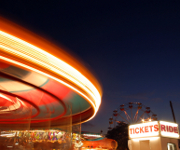
| ||||||||||||||||||||||
Carousel
| ||||||||||||||||||||||
Carousel marks the second year of the large scale musical theatre performance within the Conservatoire.
Company
Creative Team
Director: Andrew Panton
Musical Director: Simon Beck
Choreographer: Emily-Jane Boyle
Associate Director: Susie Dumbreck
Set Designer: Alex Lowde
Lighting Designer: Simon Wilkinson
Sound Designer: Blair Omond
Projection Designer: Tim Reid
Technical Production Team
Stage Manager:
Deputy Stage Manager: Amber McClelland
Assistant Stage Management: Mark Blythe, Stuart Lord
Technical Stage Manager: Rebecca Coull
Flyperson: Ian Smyth
Automation Operator: Fraser Milroy
Revolve Operator: Mary Crook
Chief Electrician: Neil Foulis
Deputy Electrician: Audrey Wilson
Sound Designer/ Sound Number 1: Blair Omond
Sound Number 2: Laura Dougan
Lighting Operator: Audrey Wilson
Electricians:
AV Operator: Robert Butler
Sopt Operators: Kieran Fitzpatrick & Shannon Howard
Sound
Sound Number 1 and Sound Designer - Blair Omond
Sound Number 2 - Laura Dougan
Production Arts Team
Assistant Carpenter Robert Gear
Assistant prop maker Zoe Kemp
Sound Department Kit List
Control Kit
- 1x Midas Pro 6 Console (FOH) - 1x Midas DL371 (Control Room) - 2x Midas DL251’s (Control Room and Pit) - 1x Klark Teknik DN9331 Graphic (FOH) - 1x Apple Mac G5 with Protools and QLAB 2 - 1x Digi Design 003 Rack
Speakers and Amps
- 2x d&b E12’s (Stalls Left and Right) - 4x d&b E8’s (1st and 2nd Circle Left and Right) - 2x d&b Qi7’s (Bottom of Centre Cluster) - 3x d&b Qi Subs (Upper Section of Centre Cluster in Cardioid Arrangement) - 4x d&b E0’s, Black (Stalls Front Fills) - 12x d&b E0’s, White (Stalls, 1st and 2nd Circle Delay Fills) - 6x d&b E3’s (Stage Foldback) - 11x d&b D6 Amps (10x Permanent Install, 1x Rack Mounted in Pit) - 1x d&b D12 Amp (Permanent Install) - 1x Mackie Powered Monitor (MD Monitor)
Radio Microphones
- 6x Shure UR1M Packs - 17x Shure UR1 Packs - 1x Shure UR2 (Director’s God Mic) - 12x Shure UR4D Dual Receivers - 23x DPA 4066 Pink Headsets with Mini XLR Connector
Radio Microphone Show Frequencies
All G1E Frequency Band, UHFR, 10mW Transmitter Power
- 510.400 MHz - Phil Atkinson - Starkeeper and Doctor Seldon - 501.775 MHz - Greg Barrowman - Mr Bascombe - 487.325 MHz - James Baxter - Ensemble - 486.975 MHz - Emily Byrt - Julie Jordan - 525.950 MHz - Ruby Day - Carrie Pipperidge - 524.650 MHz - Ryan Ferrie - Enoch Snow - 515.500 MHz - Will Gosnold - Policeman and Ensemble - 514.025 MHz - Danni Irvine - Nettie Fowler - 491.675 MHz - Lyndsey Knox - Mrs Mullin - 490.900 MHz - Thomas Milligan - Ensemble - 495.350 MHz - Hayley Mulcrone - Ensemble - 494.150 MHz - Chris Pollard - Billy Bigelow - 497.025 MHz - Charlotte Smith - Ensemble - 495.775 MHz - Jeff Smyth - Jigger Craigin - 524.300 MHz - Ashlee Rose Soldo - Ensemble - 522.900 MHz - Kara Swinny - Ensemble - 490.300 MHz - Sarah Swire - Louise Bigelow and Ensemble - 488.300 MHz - Beth Taylor - Ensemble - 519.425 MHz - Matthew Tomlinson - Ensemble - 518.075 MHz - Claire Wallis - Heavenly Friend and Ensemble - 513.525 MHz - Robert Wallis - Ensemble - 511.100 MHz - Alistair - Enoch Junior - 521.775 MHz - Saoirse - Enoch’s Daughter - 520.200 MHz - Andrew Panton - Director
Microphones / DI Boxes
- 6x AKG SE 300’s - 2x DI Boxes
Microphone Stands / Cabling
- 1x Stereo Mic Bar - 4x Straight Stands (E0 Front Fills) - 7x 20m XLR Cables (Pit) - 1x 3m XLR Cable (Pit Amp Patch) - 1x 16 Way 5m XLR Loom (Radio Mic to Stage Box in Pit) - 1x 8 Way 5m XLR Loom (Radio Mic to Stage Box in Pit) - 1x 16 Way 3m XLR Loom (Control Room Amp Patch) - 1x 8 Way XLR to 1/4” Jack Loom (DigiDesign to Desk)
Orchestra
All of the orchestra were located in the orchestra pit
- 2x Flutes - 1x Oboe - 2x Clarinets - 1x Bassoon - 3x French Horns - 2x Trumpets - 3x Trombones - 1x Tuba - 1x Harp - 2x Piccolos - 4x 1st Violins - 3x 2nd Violins - 2x Violas - 2x Cellos - 1x Double Bass - 1x Percussion
Stage Management
Stage Management Sources
| Item | Source | Contact | Notes |
|---|---|---|---|
| Crates of clams | Made at the Royal Conservatoire of Scotland
Clams sourced from Mussel Inn, Gamba, Rogano |
We sourced the clams from Mussel Inn, Gamba, Rogano - seafood resturants in Glasgow. We attached the clams to the top of some shoe boxes to make the crates weigh lighter. These were removable from the crates for after the Clambake | |
Confetti |
Halo Lighting | Halo Lighting
98 - 124 Brewery Road London N7 9PG Tel: 0844 844 0484 http://www.halo.co.uk/ |
The designer wanted a 6 minute confetti drop. I managed to source a bag of flame proof confetti for £15.00 p/kg |
| Fried Chicken Boxes | Chunky Chicken | Address: 532 Sauchiehall St, Glasgow, G2 3LX
Phone:0141 332 1772 |
Chunky Chicken was able to supply us with several takeaway chicken boxes for the Prolgue. These were to be non-branded. We put pieces of bread in to look like chicken |
| Doughnuts | Sainsburys | Buchanan Galleries
236-240 Buchanan St, Glasgow 0141 332 1480 |
Sainsburys were happy to donated us with approx. 20 doughnuts as we are registered charity |
| Deck Chairs | Lawn Chairs USA | http://www.lawnchairusa.com/ |
Technical Stage Management
Scenic Elements
Cloths
- 16x5 border (Winch bar)
- Black sharkstooth gauze (CW1, short bar extensions.)
- 16x8 full black masker (CW2)
- 13x1 Border (hung off hemp bar for petal drop – DS of CW13, masking movement)
- 16x5 border (CW21, gridded to mask upper wall back wall and grid, with bar extensions.)
- 16x5 border (CW24, 6000mm from stage level, with bar extensions and pick ups)
- BP Screen (CW25, with bar extensions and pick ups, tension lines from grid down sides to stretch to.)
- 8m+ legs (off US of flyfloor to mask light leak from behind BP screen)
Other flown items
- Bucket blossom drop (CW11 operated by pull cord from flys) 16 pieces of confetti per show.)
- Starkeeper’s Ladder (CW12 – runs between tension lines to brace and stop swinging)
- Petal drop (Flown between CW13 and hemp bar DS of, operated by pulling up CW)
- Halo ring (flown on automation winches, can fly in straight or with an US-DS tilt)
Fixed set
- Revolve (operated from under LX tower SL, by DSM position)
- Built up stage (to hide revolve)
- Wall (along back of set in front of BP screen – 300x300x300 box steps added either side to allow step up to wall.)
- 2.4x6m Hard Maskers x2 (Edges of US aperture)
Trucks
- Billy’s Hut (Small Carnival booth – set DS during A1S1)
- Nettie’s Truck (Large red truck, with 4 trunk legs, on wheels; a plank revoke is set behind by cast to allow them to walk from truck to wall; separate 3 step treads with flat top)
- Julie’s Truck (Large pale coloured truck, with 3 long base sections, on wheels; separate 2 step treads with railing)
Other
- Trees x3 (spigoted into floor for first Act; USR, USL & DSL; floor infills for following acts)
- Benches x2 (carried on and off by cast)
- Pallets x9 (some bolted together to allow ease of lifting; built into stack for A2S2)
- Post box (spigot into floor; lights up).
Revolving Stage (Dundee Rep Revolve)
Centre stage for this performance there was a revolving stage, 6m in diametre. We borrowed this from Dundee Rep; in order to power it we also hired jumps, distro and a variable RCD from Tower Productions Edinburgh. The stage surround and ramps were built by the RCS Workshop.
Please see Dundee Rep Revolving Stage for more details, power requirements and operational instruction.
Note: for this production we situated the operator DSL by the DSM position in order to allow her a clear line of sight when operating, she also had a monitor with an overhead view. These were initially safety measures to allow a double check of performers and set positioning before movement. However as we experienced issues with the revolve stopping on the correct marks the operator stopped the revolve by pressing the stop button on the control at a particular point which would allow it to decelerate and stop at the correct position, to do this she put marks on the monitor, where she would press stop when it passed this.
Halo Ring on Automation
Overview
| Carousel Grid: Line Drop Points | |
|---|---|

| |
One of the main features of the design was the halo ring which lit up and flew in to almost the deck and out to amongst the Lx rig, it also was required to tilt on an US-DS axis. This was tricky as it required that the Lx bars were rigged on trapeze bars and on very precise points on the bars – please see Lx Trapeze Bar points for details.
The other challenge with this was rigging it from the automation itself, various methods were discussed; including counterweight slave bars, flying it directly from the winch lines and hanging truss or bars from the winch lines to then hang the halo from. In the end we went with the final option as the weight change when it tipped would have made weighting it correctly on a counterweight bar difficult; we could not fly it directly from the lines at the winch line drops can only be placed in particular positions on the grid and none of these lined up correctly with the pick up points on the Halo. The final option was what we went with, the automation lines ran down to a bridle, which was attached to a pair or scaffold steel bars clamped together with vertical couplers, from this 6m drifts to the ring itself. This allowed us the greatest control over the weight distribution and tilt.
Stats
- Halo ring constructed in 3 sections which are bolted together.
- Individual section weighs 53kg – complete halo weighs 159kg (plus weigh5t of scaffold bars on the winch lines) .
- The Halo has an outside diameter of 6 metres.
- The pick-up points on the halo are if put into a square 3895mm from each other.
- We set the minimum height the halo came in to as 300m, the absolute maximum it could fly out was 6500mm.
Equipment Used
- X4 Stage Technologies winches
- X4 Short black and red 24kN strops
- X4 3.2T shackles
- X8 1.5m drift
- X8 1T shackles
- X8 ¾ T shackles
- X4 6m drifts
- X8 barrel clamps
- X8 vertical scaff couplers
- X4 7.4m lengths of steel scaff.
Rigging
Pairs of steel bars are attached together using 4 vertical scaff couplers for each pair.
- The scaff couplers are spaced 985mm and 2950 from the centre of the bar out each way.
The barrel clamp points on the bottom bar (which are attached to the drifts to the halo) are 1948 from centre of the bar each way.
The barrel clamp points on the top bar (which are attached to the bridle) are 2000mm and 3400mm from the centre of the bar each way.
The each bridle is attached to the short strop from the winch line wedge socket using a 3.2T shackle to the line, two 1.5m drifts are attached to this, to a 1T shackle on the end of each drift to the barrel clamp on the bar.
The halo is attached via the remaining shackles and 6m drifts to the barrel clamp on the bottom bar.
Lx Trapeze Bars
In order for the Halo to fly up in among the lighting rig, the lx bars surrounding it had to be rigged on trapeze.
| Carousel: Lx Trapeze Bars | |
|---|---|

| |
| Note: CW - Measured from centre of Counterweight bar; Tpz - Measured from centre of Trapeze Bar | |
Trapeze Bar Lenths
- Lx1 - x2 6.4m
- Lx1a - 1m
- Lx2 - x2 3m and x1 4m
- Lx3 - x2 3m and x1 4m
- Lx4 - x2 6.4m
Equipment Used
- x44 barrel clamps
- x44 1T bow shackles
- x18 6m drifts
- 4 2m drifts (used for Lx1)
Starkeeper's Ladder
Overview
During the second act a ladder was required to fly in and a performer to be able to climb it. To do this workshop built a ladder from steel which made it very sturdy (and very heavy at 100kg), which was then rigged from a secondary bar rigged to the counterweight bar by vertical couplers – this made the weight distribution on the bar better and stopped it bending).
To prevent the ladder swinging when the performer climbed it, it flew between two tensioned lines - turfer line and a ratcheted drift which were attached using a series of strops in a bridle to the structural beams at flyfloor level, until the lines were in the correct position.
Equipment Used
- Turfer
- 15m 8mm 7x19 construction drift
- x4 2m strop
- x2 masterlink
- x3 3.2T shackle
Petal Drops
Main Petal Drop
Small Petal Drop
Lx Towers
There were 3m high platforms put in place on either side of the stage well offstage and tight behind the tormentors for Lx follow spot positions.
SL Platform
This platform was constructed over the DSM desk position, tight to the onstage edge of the door.
Equipment Used
- 8x4 steel deck
- X4 3m legs
- 3.1m scaff bar.
- x4 swivel clamps
- 90 degree scaff clamp
- X2 4ft long railings.
- X4 M10 bolts and nuts
- X5 Key clamp feet
- 1m deck leg
- X1 ratchet
The tower was built on 4 3m legs with key clamp feet; the US edge was braced using the 3.1m scaff bar and 2 swivel clamps. The DS onstage leg was clamped near the top and the bottom to the tormentor (which was drop bolted in place) using swivel clamps. The DS offstage leg had a 1m deck leg with a key clamp foot attached to it (with the 90degree clamp) bracing it against the wall and a ratchet was attached to the DS of the deck and to an eye loop bolted onto the wall to pull it tight in.
This all made the tower very stable, the railing was then added.
To access the platform a truss ladder was hung from the fly floor using:
- X2 1m strops
- X4 mailons
- X1 truss ladder
An inertia reel was rigged by venues and the operator was required to wear a harness attached to this to go up.
SR Tower
The stage right tower was constructed in the same manner, however a 4x4 deck was used and only one railing. A fixed ladder was attached to this deck. The operator was still required to wear a harness.
General Notes
Masking Notes
- Two 4x12 legs tied off to the US of the flyfloors prevented the light leak from behind the BP screen into the US wings.
- The USL entrance to the wing was masked by a 4x3.8 tab tied to a pipe along the ceiling to hide the entrance from scene dock to US and the props table also situated there.
- The US wall had light leaks between the planks, we stapled black tat over these gaps on the inside of the wall.
- A 13x1m border was hung along the DS of the main blossom drop.
- Black tat was cable tied to the scaff bars the halo was rigged from to mask them more when the halo was in its lowest positions.
BP Screen
- 48mm scaff pipes were put through the bottom of the BP screen to weight it down, these were joined by bar extension narrow pipes to prevent an obvious join.
- 15m drifts were ratcheted from the grid to the deck (where they were attached to a flying plate screwed to the floor) to allow the screen to be stretched to using cyc stretchers.
DS Black and Gauze
The DS full balck was brailed close to the gauze to make room for Lx1, this caused the fabric of the black and the gauze to get stuck together, resulting in when the black was flown the gauze being pulled some way out and then it dropping and the conduit thumping on the ground.
We established this was due to the auditorium being much warmer than the stage and the black being pulled towards that heat through the gauze.
To stop this happening we carefully set the black, flying the gauze in first and then flying the black in, pulling it upstage as it came in, so when it reached the deck there was a gap of at least 500mm between it and the gauze, we then put a stage weight in front of it to stop it being pulled forwards again. Just prior to the cue for the black going out we would have 2 people in either wing who would remove the stage weight and hold the black in position just before the cue and let it go as it flew out, these crew members would also hold the conduit of the gauze down as the black flew, as an extra measure in case it still caught.
Electrics
LX Photos
LX Equipment
Generic Lamps
- SL 15-32 - 21
- SL 19* - 12
- SL 23-50 - 20
- SL 26* - 8
- 1.2K Fresnel - 33
- 1.2K PC - 2
- 2K Fresnel - 11
- 5K Fresnel - 1
- PAR 64 - 30 (10 CP 61, 20 CP 62)
- S4 PAR - 1
- Birdies - 11
- Coda FLood - 28
- Orion Groundrow - 8
Special Lighting Effects
- Vari Lite 1000 tsd - 4
- Reiche and Vogul Beamlights - 2
- Le Maitre MVS Hazer - 1
- Festoon 15M - 1
Festoon
Festoon was used to create a circus atmosphere, Because this was handled by the cast, it was required to be shatterproof. it took 30 x 40 Watt pearl Shatterproof bulbs for one 15M length of festoon.
These Bulbs were bought from a supplier called Covershield.
Lightbulb Halo
The Lightbulb Halo was a main part of the set, as it was the main element representing the Carousel.
My task was to wire up all 80 Lightbulbs in 4 circuits, so it could chase and look as though they were all chasing round the ring.
Firstly I found out the measurement between bulbs, (I used my Vectorworks plan to do this) and then made a template, see below.
I then laid out all the fittings where they go on the ring, and began wiring.
This was wired in Parallel, Each Live, and Neutral went in to the live and neutral points, and then out, and on to the next one. see explanation on Parallel wiring.
Final wiring in 4 circuits
Booms
all of the stage booms required to sit in line with the edge of the fly floor
unfortunately this meant they were sitting on the ramp up to the stage, So to solve this problem, we built small anti rakes to sit under the boom bases.
3 of the booms were to be 7 metres high, this was relatively easy to achieve, the 7M pole was tied to the fly floor, making them very rigid.
Star
the first star, (the understudy) was simple, if a little large. a simple circuit concealed inside a miniature Gin Bottle.
1x warm white LED 2x 1.5V Batteries 1x simple push switch small amount of wire.
The second star (THE star)
was another simple circuit, I used a smaller battery, and a simpler switch.
Overhead rig
(lighting plan designed by simon wilkinson)
The Halo needed to sit above the lighting bars, so it could disappear above the lamps.
this meant rigging all the bars on trapezes, the plan gives an idea of where the bars were to sit, this did mean a lot of time to work out where all the lamps were to plug in & Pair
